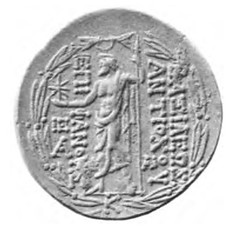
PREV ARTICLE
NEXT ARTICLE
FULL ISSUE
PREV FULL ISSUE
PROFESSOR STUDIES ASTROLOGICAL SYMBOLS ON COIN OF ANTIOCHOS VIII
Arthur Shippee forwarded this article about a coin of Antiochos VIII depicting a rare celestial event. It turns out that Marshall Faintich isn't the only active scholar with an interest in astronomy and ancient coins. I contacted Prof. Weir and he wasn't aware of Faintich's book, and he thanked me for letting him know.
-Editor
On one side is a portrait of Antiochos VIII, the king who minted it. On the reverse is a depiction of Zeus, either nude or half-draped, holding a sceptre in his left hand. Above the god's head is the crescent of the moon, and his right arm is outreached with a star like figure (that may in fact be Jupiter) hovering just above his palm. "Nobody ever re-used this iconography again – it was a one off," said Professor Robert Weir, of the University of Windsor in Canada, who presented his research recently at the annual meeting of the Archaeological Institute of America. Weir is a Classics professor with an interest in astronomy and ancient coins. He was curious why Antiochos VIII would mint a piece of currency with such an unusual drawing – could there have been something going on in the night sky? "I did some calculations to see what was visible from Antioch, the capital of the Seleucid Empire – I came up with some interesting patterns." Weir found that on January 17, 121 BC, the city's residents would have seen Jupiter blocked out by the moon, an event modern day astronomers call an "occultation."
I contacted Prof. Weir and he wasn't aware of Faintich's book, and he thanked me for letting him know.
-Editor
To read the complete article, see:
2,100 year-old Greek coin may have marked rare astronomical event
(www.unreportedheritagenews.com/2011/01/ The Numismatic Bibliomania Society is a non-profit organization promoting numismatic literature. See our web site at coinbooks.org. To submit items for publication in The E-Sylum, write to the Editor at this address: whomren@gmail.com To subscribe go to: https://my.binhost.com/lists/listinfo/esylum All Rights Reserved. NBS Home Page Contact the NBS webmaster 
|
 An unusual Greek coin, minted around 120 BC, may have marked a moment in time when people in ancient Syria saw Jupiter being blocked out by the moon.
An unusual Greek coin, minted around 120 BC, may have marked a moment in time when people in ancient Syria saw Jupiter being blocked out by the moon.